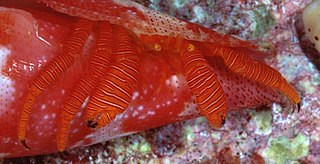
The halloween hermit crab, also known as the striped hermit crab or orange-legged hermit crab, is a brightly colored aquatic hermit crab of the family Diogenidae. Besides its ability to routinely clean algae in aquaria, the halloween hermit crab's festive striped coloration also appeals to enthusiasts; it is considered the most brightly colored hermit crab in normal aquarium use.

The Diogenidae are a family of hermit crabs, sometimes known as "left-handed hermit crabs" because in contrast to most other hermit crabs, its left chela (claw) is enlarged instead of the right. It comprises 429 extant species, and a further 46 extinct species, making it the second-largest family of marine hermit crabs, after the Paguridae.

Ciliopagurus is a genus of hermit crabs, of the family Diogenidae, which are sometimes referred to as the "left-handed hermit crabs", because in contrast to most other hermit crabs, the left chela (claw) is enlarged instead of the right. They are found in the Indo-Pacific region and in the eastern Atlantic Ocean.
Ciliopagurus albatrossi is a species of hermit crab native to the Hawaiian region.
Ciliopagurus alcocki is a species of hermit crab native to New Caledonia.
Ciliopagurus babai is a species of hermit crab native to Wakayama.
Ciliopagurus haigae is a species of hermit crab native to Tanzania.
Ciliopagurus liui is a species of hermit crab native to the Gulf of Tonkin and waters to the south of Japan.
Ciliopagurus macrolepis is a species of hermit crab native to Indonesia.
Ciliopagurus major is a species of hermit crab native to French Polynesia.

Ciliopagurus pacificus is a species of hermit crab native to French Polynesia.
Ciliopagurus plessisi is a species of hermit crab native to French Polynesia.
Ciliopagurus caparti is a species of hermit crab native to South East Atlantic.

Ciliopagurus galzini is a species of hermit crab. It is one of four species in the "strigatus complex"; it resembles C. strigatus, with the most prominent difference being coloration. It is common in the shallow intertidal waters of the Tuamotus.
Ciliopagurus hawaiiensis is a species of hermit crab native to Hawaii.
Ciliopagurus krempfi is a species of hermit crab from the Indo-Pacific.
Ciliopagurus obesus is a fossil species of hermit crab, described from Rupelian (Oligocene) sediments at Sint-Niklaas, Belgium.
Ciliopagurus shebae is a species of hermit crab native to Madagascar, the Red Sea, Réunion, the Seychelles, and the West Indian Ocean.
Ciliopagurus tenebrarum is a species of hermit crab native to Cape Comorin.
Ciliopagurus vakovako is a species of hermit crab native to the Marquesas Islands. It is typically found at a depth no lower than 57 metres (187 ft). C. vakovako appears to be a vicariant of C. strigatus, a species widespread throughout the Indo-pacific region.



